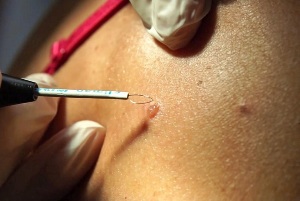
Most of the time, people do not suspect that they have human papillomavirus (HPV) in their body. This is because the papillomavirus is usually latent, suppressed by natural immunity. Problems arise when he gets out of control and begins to actively manifest himself in the form of growths in various parts of the body. Men are less likely to suffer from the effects of the virus than women, however, for them, its effect can turn into serious problems in the form of papillae in the penis.
Causes of occurrence
Viral DNA enters the body through micronuclei in the skin or mucous membranes. If a man's immunity weakens, the first manifestations of HPV will appear several months after infection.
Up to 80% of transmission is through sexual intercourse. Barrier contraception minimizes the risk of infection, but does not completely eliminate it.
Other ways of infection:
- Home route.The virus is transmitted along with the personal belongings of an infected person: clothes, sanitary ware, etc. The risk of transmission increases if the skin is damaged, even small. This route is characterized by infection with a low oncogenic virus type. They do not lead to serious health problems, but appear in the form of genital warts, papillomas and warts, creating a cosmetic defect.
- From mother to child.If the mother became infected with HPV during pregnancy and childbirth and was born naturally, the baby is more likely to be infected.
If a man has a good immune defense, the virus does not manifest and can remain in the body for a long time in latent form. Therefore, it is not the infection with the virus itself that is dangerous, but the weakening of the immune system, which leads to the activation of HPV.
There are several factors that can enhance the position of the virus:
- chronic diseases?
- hormonal problems?
- incorrectly selected contraception or its complete absence.
- viral infections?
- alcohol, smoking or long-term use of antibiotics.
- frequent stress.
All of these factors negatively affect the immune system. If in a man's life there is not one causative factor, but several, it will lead to a faster development of the papilloma virus.
Symptoms
Often, papillomas occur only externally, however, in some cases, non-specific symptoms may occur:
- itching and burning during sexual intercourse
- pain when touching nipples.
- accumulation of urine in the folds of the penis.
- unpleasant odor in the affected area.
In addition, tumors can grow and affect not only the penis area, but also the anus and pubic area.

What nipples look like
The papillary papilla is a small tumor. At first, it may appear on its own, but without proper treatment, the number of papillomas increases. However, they can be merged with each other.
These growths look like flesh-colored or pink cauliflower inflorescences. They are most often found in the foreskin, head and vagina. Less often, they are diagnosed in the urethra and scrotum. Papules can also appear as small white pimples that appear in large rows. This form is typical for locating the carpet area.
One of the manifestations of HPV is Buschke-Levenshtein warts. It is distinguished by its rapid growth, its exceptional size and its resistance to various types of treatment. Its appearance is due to many existing papillomas and warts, which merge and form a large area of damage. The presence of Buschke-Levenshtein wart is dangerous because the cells that change from it can easily develop into cancer.
Which doctor to contact
As a rule, a urologist diagnoses papillomas in men. You can also seek advice from a dermatobiologist or proctologist if you have genital warts in the anal area. However, papillomas are usually referred to a surgeon for removal. Overall, the diagnosis is made in several stages:
- The urologist examines and interviews the patient. The verbal question is necessary to assess the patient 's lifestyle and to determine the cause of the virus infection. The visual inspection includes not only the assessment of the condition of the penis, but also the adjacent organs - the scrotum, the anal area. This is necessary to complete the image of the virus detection.
- Urethral smear.Identifies the presence of various sexually transmitted diseases.
- PCR.This test not only shows the presence of HPV in the body, but also most likely determines its type.
- Meatoscopy. This procedure is to examine the urethra if the papilloma virus has infected the frenum.
- After removing thenipple, your doctor may order a biopsyto evaluate the condition of the removed tumor. This is necessary to rule out the risk of cancer and to make sure the beast is benign.
In this case, it is desirable to conduct research on both partners. Usually a woman is also infected with one of the types of papillomavirus. If only one man is treated, it is very likely that he will get sick again after a while.
Why papillomas are dangerous
The human papillomavirus is often accompanied by other related diseases. The appearance of papillae in the area of the lash penis contributes to the accumulation of urine in the folds. This creates conditions for the appearance and growth of various microorganisms, which then lead to infections. They can cause erosion around the nipples and also contribute to inflammation of the urethra and testicles. These diseases are characterized by problems with urination, pain and high fever.Another risk is trauma to the neoplasms, which leads to bleeding. This is due to the fact that many blood vessels form around the nipples, which supply blood. Even minor damage can lead to infection due to injury.
Also, neoplasms can rub when they move, which causes pain and discomfort to the man.
HPV and cancer
When the virus is just beginning to spread, the tumors are sporadic and benign. Without treatment, they grow and merge with each other. Over time, the cells degenerate into malignant.The risk of cancer is especially high if a man is infected with very oncogenic types of the virus - 16 or 18.They are the ones who contribute to the development of penile and bladder cancer.
Treatment of papillomas
Treatment with HPV involves not only removing its external manifestations, but also strengthening the immune system, which should rule out the manifestations of the virus.Immunostimulants are used to maintain immunity.
As an antiviral drug, an ointment that suppresses the spread of the virus and removes small growths is effective. It does not always face the task of complete removal, but prevents the emergence of new developments. Antiviral ointment is prescribed to boost immunity. The ointment does not remove the papillae, but promotes the activation of the cells of the immune system, which stops their growth and development.

Removal Methods
There are several ways to get rid of new developments that have occurred:
- Laser removal.The beast is exposed to a laser beam, which completely burns the growth. A crust forms in this area, which subsides after a few weeks. The method is considered effective due to the absence of recurrences. The removal is done under anesthesia. There is no bleeding, no scars or scars.
- Cryodestruction.Nipples are exposed to liquid nitrogen. It immediately freezes the desired area, the tumor on it collapses and dies. The disadvantage of this method is the inability to control the depth of the effect of cryopreservation. In place of the removed papilla, there remains also a crust, which disappears after a while.
- Radiosurgery.The principle of this method is similar to laser removal. The radio waves do not leave scars and marks and the procedure precedes the preliminary anesthesia with a special spray. After that there are no complications and the body recovers quickly.
- Electrocoagulation.The growth is affected by an electric current, due to which the foot is expelled, after which the nipples disappear. If required, superficial anesthesia may be given. The process takes several minutes, is widespread and affordable. But this method is able to leave scars after healing.
- Surgery.Used in rare cases when the tumor becomes very large. It is done under anesthesia, has a long treatment and trauma. The method is good as it allows you to save the removed growth for histological examination.
The cost of each method depends on the complexity of the work, the size and the number of papillae to be removed.
Before choosing a method, consult your doctor. It will tell you what is best to use in your case, it will tell you in detail how the process is performed. Also, after removal of the tumor, it is recommended to take the material for histology. This is necessary to determine if the process of degeneration of benign neoplasms into malignancies has begun. This method will help detect early cellular changes and prevent the cancer from spreading.














































































